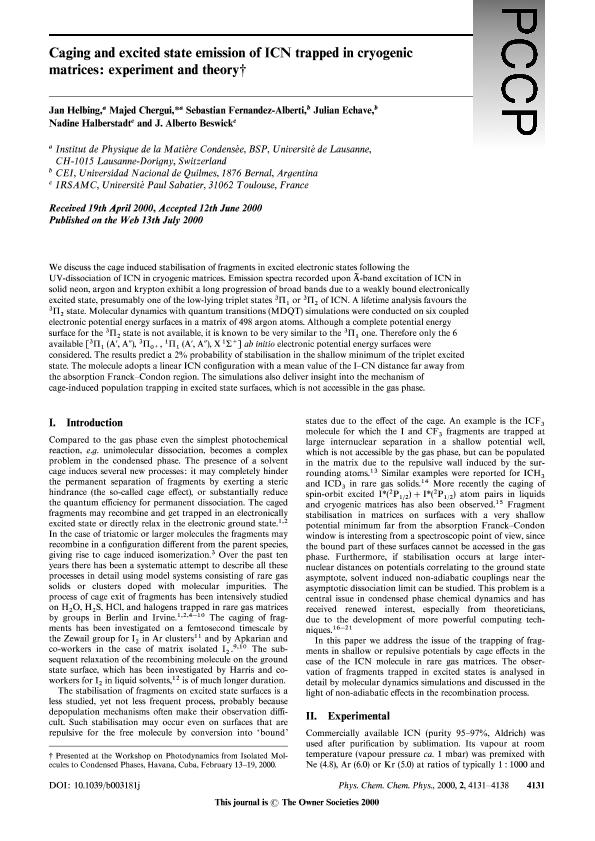Mostrar el registro sencillo del ítem
dc.contributor.author
Helbing, J.
dc.contributor.author
Chergui, M.
dc.contributor.author
Fernández Alberti, Sebastián

dc.contributor.author
Echave, Julián

dc.contributor.author
Halberstadt, N.
dc.contributor.author
Beswick, J. A.
dc.date.available
2019-03-14T20:56:03Z
dc.date.issued
2000-09
dc.identifier.citation
Helbing, J.; Chergui, M.; Fernández Alberti, Sebastián; Echave, Julián; Halberstadt, N.; et al.; Caging and excited state emission of ICN trapped in cryogenic matrices: Experiment and theory; Royal Society of Chemistry; Physical Chemistry Chemical Physics; 2; 18; 9-2000; 4131-4138
dc.identifier.issn
1463-9076
dc.identifier.uri
http://hdl.handle.net/11336/71719
dc.description.abstract
We discuss the cage induced stabilisation of fragments in excited electronic states following the UV-dissociation of ICN in cryogenic matrices. Emission spectra recorded upon A-band excitation of ICN in solid neon, argon and krypton exhibit a long progression of broad bands due to a weakly bound electronically excited state, presumably one of the low-lying triplet states 3Π1 or 3Π2 of ICN. A lifetime analysis favours the 3Π2 state. Molecular dynamics with quantum transitions (MDQT) simulations were conducted on six coupled electronic potential energy surfaces in a matrix of 498 argon atoms. Although a complete potential energy surface for the 3Π2 state is not available, it is known to be very similar to the 3Π1 one. Therefore only the 6 available [3Π1 (A', A''), 3Π(o)+, 1Π1 (A', A''), X 1Σ+] ab initio electronic potential energy surfaces were considered. The results predict a 2% probability of stabilisation in the shallow minimum of the triplet excited state. The molecule adopts a linear ICN configuration with a mean value of the I-CN distance far away from the absorption Franck-Condon region. The simulations also deliver insight into the mechanism of cage-induced population trapping in excited state surfaces, which is not accessible in the gas phase.
dc.format
application/pdf
dc.language.iso
eng
dc.publisher
Royal Society of Chemistry

dc.rights
info:eu-repo/semantics/openAccess
dc.rights.uri
https://creativecommons.org/licenses/by-nc-sa/2.5/ar/
dc.subject
Photodynamics
dc.subject
Caging
dc.subject
Condensed Phase
dc.subject.classification
Otras Ciencias Físicas

dc.subject.classification
Ciencias Físicas

dc.subject.classification
CIENCIAS NATURALES Y EXACTAS

dc.subject.classification
Otras Ciencias Químicas

dc.subject.classification
Ciencias Químicas

dc.subject.classification
CIENCIAS NATURALES Y EXACTAS

dc.title
Caging and excited state emission of ICN trapped in cryogenic matrices: Experiment and theory
dc.type
info:eu-repo/semantics/article
dc.type
info:ar-repo/semantics/artículo
dc.type
info:eu-repo/semantics/publishedVersion
dc.date.updated
2019-03-14T14:14:11Z
dc.journal.volume
2
dc.journal.number
18
dc.journal.pagination
4131-4138
dc.journal.pais
Reino Unido

dc.description.fil
Fil: Helbing, J.. Universite de Lausanne; Suiza
dc.description.fil
Fil: Chergui, M.. Universite de Lausanne; Suiza
dc.description.fil
Fil: Fernández Alberti, Sebastián. Universidad Nacional de Quilmes. Centro de Estudios e Investigación; Argentina. Consejo Nacional de Investigaciones Científicas y Técnicas; Argentina
dc.description.fil
Fil: Echave, Julián. Universidad Nacional de Quilmes. Centro de Estudios e Investigación; Argentina. Consejo Nacional de Investigaciones Científicas y Técnicas; Argentina
dc.description.fil
Fil: Halberstadt, N.. Université Paul Sabatier; Francia
dc.description.fil
Fil: Beswick, J. A.. Université Paul Sabatier; Francia
dc.journal.title
Physical Chemistry Chemical Physics

dc.relation.alternativeid
info:eu-repo/semantics/altIdentifier/doi/http://dx.doi.org/10.1039/b003181j
dc.relation.alternativeid
info:eu-repo/semantics/altIdentifier/url/https://pubs.rsc.org/en/Content/ArticleLanding/2000/CP/b003181j
Archivos asociados
